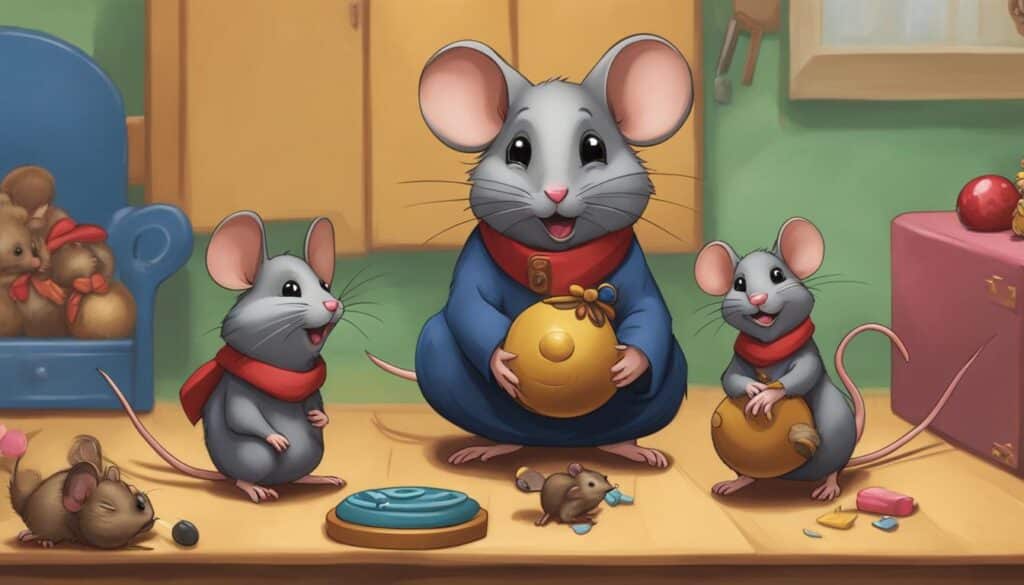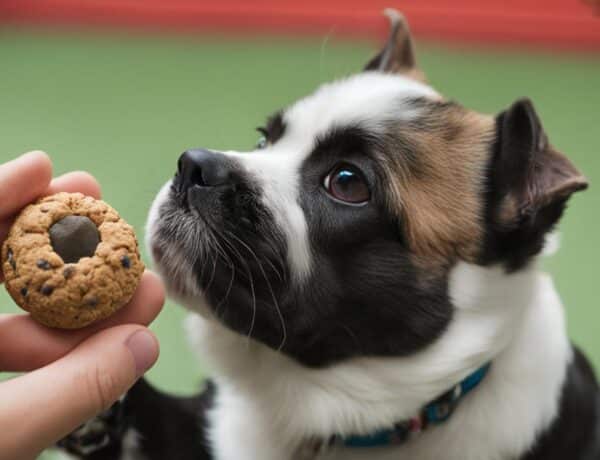In my experience as a rodent enthusiast, I have discovered that taming and training small rodents, such as pet mice, is not only possible but also a rewarding endeavor. It requires patience, consistency, and the ability to understand and gain the trust of these fascinating creatures.
When it comes to taming small rodents, starting with young mice is often easier as they are more receptive to human interaction. Additionally, it is crucial to avoid stressing the mouse during routine activities, as it can hinder the taming process.
One effective method for taming small rodents is using treats as a way to gain their trust. By offering treats through the cage bars and gradually progressing to placing treats on your open hand for the mouse to retrieve, you can establish a positive association between your presence and rewards.
Building trust is the key to successful taming. As the mouse becomes comfortable climbing onto your hand to receive treats, you can attempt gentle scratching to further strengthen the bond. Remember, consistency is paramount, so maintain a regular routine of interaction and positive reinforcement.
Key Takeaways:
- Taming pet mice requires patience, consistency, and trust-building techniques.
- Starting with young mice can make the taming process easier.
- Avoid stressing the mouse during routine activities.
- Use treats as positive reinforcement to gain the mouse’s trust.
- Gradually progress from offering treats through the cage bars to placing treats on your open hand for the mouse to retrieve.
Tips for Taming Pet Mice
Taming a mouse requires patience, consistency, and a gentle approach. By following these tips, you can gradually build trust and form a bond with your pet mice.
1. Take it slow
When taming a mouse, it’s essential to take things at their pace. Mice are naturally curious but can also be skittish, so rushing the process may cause them to become fearful. Start by simply sitting near their cage and talking softly to them, allowing them to become familiar with your presence.
2. Use treats as positive reinforcement
Mice are motivated by food, making treats an effective tool for taming. Begin by offering treats through the cage bars, allowing the mouse to associate your presence with something positive. Slowly progress to placing treats on your open hand, encouraging the mouse to retrieve them. This will encourage them to approach and interact with you.
3. Gradually introduce handling
Once the mouse is comfortable taking treats from your hand, you can start introducing gentle handling. Place your hand in the cage, palm up, and allow the mouse to climb onto it. If they are hesitant, continue offering treats as an incentive. Once they are comfortable climbing onto your hand, try gently scratching their back or head to further build trust and bonding.
“Taming a mouse is all about gaining its trust.”
With time and patience, your pet mice will become more comfortable and trusting. Remember to always handle them gently and avoid sudden movements that can startle them. By following these tips and consistently working with your mice, you can form a strong bond and enjoy the companionship of your tamed pet mice.
| Tips for Taming Pet Mice |
|---|
| Take it slow |
| Use treats as positive reinforcement |
| Gradually introduce handling |
Tips for Taking Care of Pet Mice
When it comes to caring for pet mice, there are a few important factors to consider. By following these tips, you can ensure that your mice are happy, healthy, and well-adjusted.
Keeping Pet Mice in Groups
Mice are social creatures and thrive when they have companionship. It is best to keep pet mice in groups of females, as male mice tend to be aggressive and may fight with each other. By providing a group environment, you can help fulfill their social needs and create a harmonious living space.
Allowing Time for Adjustment
When you introduce new mice to their environment, it is essential to give them time to adjust before interacting with them. These small creatures can be sensitive to changes, and it’s important to allow them the opportunity to feel safe and secure in their new surroundings. Starting with a calm and stress-free environment will help them become familiar with their new home.
Creating a Safe Play Area
Just like any other pets, mice also need regular exercise and mental stimulation. It’s crucial to create a designated play area outside the cage where your mice can explore and engage in activities. This play area should be safe and free from any potential hazards or escape routes. Fill it with toys, tunnels, and climbing structures to keep your mice entertained and stimulated.
| Benefits of Keeping Pet Mice in Groups | Creating a Safe Play Area for Pet Mice |
|---|---|
|
|
By following these tips, you can provide optimal care for your pet mice, ensuring a happy and fulfilling life for these adorable creatures.
The 1-2-3 Magic Approach to Parenting
The 1-2-3 Magic approach is a behavior management technique that emphasizes consistency. It involves counting infractions and giving time-outs when necessary. This approach helps to establish clear boundaries and teach children obedience and good judgment.
Consistent parenting is key to raising well-behaved children. With the 1-2-3 Magic approach, parents can effectively manage their children’s behavior and create a harmonious household. By setting clear expectations and implementing consequences in a structured manner, this method empowers parents to address challenging behaviors.
1-2-3 Magic is all about simplicity and consistency. By following three simple steps, parents can effectively manage their child’s behavior:
- Counting: When a child misbehaves, parents calmly count “1” to give the child a warning.
- Counting again: If the child continues the misbehavior, parents count “2” as a second warning.
- Time-out: If the misbehavior persists, parents count “3” and give the child a time-out.
This behavioral management technique helps children understand the consequences of their actions and learn to make better choices. It provides a consistent and predictable structure that children can rely on, reducing power struggles and promoting positive behavior.
Benefits of the 1-2-3 Magic Approach
The 1-2-3 Magic approach offers several benefits for both parents and children:
- Clear boundaries: By establishing a clear counting system, children understand what is expected of them, allowing them to develop self-discipline and make better choices.
- Consistency: Consistency is key to effective parenting. The 1-2-3 Magic approach provides a consistent method for addressing misbehavior, helping parents stay calm and consistent in their responses.
- Teaches responsibility: When children face consequences for their actions, they learn to take responsibility for their behavior and understand that their choices have an impact on themselves and others.
- Encourages communication: The 1-2-3 Magic approach encourages open communication between parents and children. It provides an opportunity for parents to explain the reasons behind the counting system and engage in meaningful conversations about behavior and expectations.
By implementing the 1-2-3 Magic approach, parents can effectively manage their children’s behavior, promote self-discipline, and foster a positive parent-child relationship based on trust and mutual respect.
Factors Affecting Memory and Behavior in Rodents
Memory and behavior in rodents are influenced by various factors, such as their focus, motivation, and inner state. These factors play a crucial role in shaping how rodents behave and remember information. Understanding these influences is key to comprehending the complexities of rodent behavior.
When it comes to memory, rodents’ focus on certain stimuli can greatly impact their ability to recall information. Similar to humans, rodents may become distracted or overwhelmed by external factors, leading to difficulties in retaining memories.
Additionally, the motivation level of rodents can significantly affect their memory and behavior. Motivation can be influenced by external rewards, such as food, or internal drives, such as the need for social interaction. Rodents with higher motivation levels often exhibit enhanced memory performance and more goal-directed behavior.
The inner state of animals, including rodents, can also play a critical role in their memory and behavior. Factors such as stress, fear, or hunger can influence rodents’ cognitive abilities and affect their overall behavior. For instance, a stressed rodent may exhibit impaired memory and altered behavior compared to a relaxed and contented one.
“Understanding the factors that influence memory and behavior in rodents is essential for conducting accurate research and effectively interpreting their actions.”
Studying these factors allows researchers to gain a deeper understanding of rodent behavior and memory. It helps shed light on how these animals interact with their environment and adapt to different situations. By examining the various influences on memory and behavior, we can enhance the welfare of rodents and make informed decisions about their care and training.
In summary, memory and behavior in rodents are not solely determined by innate factors but are also influenced by external and internal elements. Researchers continue to explore the complex interplay between focus, motivation, and inner state to unravel the mysteries of rodent cognition and behavior.
| Factors | Influence on Memory and Behavior |
|---|---|
| Focus | Affects the ability to retain and recall information. |
| Motivation | Determines the level of engagement and goal-directed behavior. |
| Inner State | Affects cognitive abilities and overall behavior. |
The Relationship Between Memory and Behavior
When studying the behavior of animals, particularly rodents, it is crucial to understand the complex relationship between memory and behavior. While memory certainly plays a role in shaping behavior, it is important to recognize that behavior alone does not provide a direct indication of the presence or absence of memory.
Behavior is influenced by a multitude of factors, including genetic predispositions, environmental stimuli, and current internal states. While memory is one of these factors, it is just one piece of the puzzle. Therefore, it is not accurate to conclude that behavior is equal to memory.
One common pitfall in interpreting animal behavior is reverse inference, which involves making assumptions about an animal’s memory based solely on its observed behavior. However, behavior is influenced by a wide range of factors beyond memory, making it unreliable to draw conclusions in this manner.
“Memory and behavior are intricately linked, but it is important to remember that behavior is not a direct reflection of memory. An animal’s behavior can be influenced by a variety of factors, and it is essential to consider multiple lines of evidence when studying memory in animals.”
Factors Influencing Behavior
To further emphasize the point, let’s explore some of the factors that can influence behavior in rodents:
- Motivation: An animal’s level of motivation can greatly influence its behavior. For example, hunger or fear can drive certain behaviors regardless of an individual’s memory capabilities.
- Environmental Stimuli: The environment in which an animal is placed can elicit a wide range of behaviors. Different smells, sounds, and visual cues can have immediate effects on behavior, whether or not memory is involved.
- Internal States: An animal’s current internal state, such as stress levels or physiological changes, can significantly impact behavior. These internal factors can influence behavior independently of memory.
By considering these and other factors, researchers can gain a better understanding of the intricate relationship between memory and behavior in rodents. It is essential to avoid oversimplifications and to acknowledge the complexity of the interactions at play.
Summary
Memory and behavior in rodents are undeniably connected, but behavior alone is not a reliable indicator of memory. Various factors, including motivation, environmental stimuli, and current internal states, influence behavior independently of memory. Therefore, it is crucial to approach the study of memory and behavior in rodents with a comprehensive understanding of the multitude of factors involved.
| Memory and Behavior Relationship | Reverse Inference | Behavior not equal to Memory |
|---|---|---|
| Behavior is influenced by multiple factors, including memory. | Reverse inference can lead to erroneous conclusions about memory based solely on behavior. | Behavior is not a direct reflection of memory alone. |
| Memory is just one piece of the puzzle in shaping behavior. | Interpreting behavior solely as an indicator of memory is unreliable. | Behavior is impacted by various internal and external factors beyond memory. |
Conclusion
In conclusion, taming and training wild behavior in small rodents, such as pet mice, requires dedication and understanding. Patience and consistency are key in building trust and establishing a bond with your small rodent pet. By using positive reinforcement techniques, such as offering treats and creating a safe environment, pet owners can effectively shape the behavior of their mice.
Gaining the trust of a pet mouse takes time, especially when starting with young mice. It is important to avoid stressing the mouse during routine activities and handle them gently. Gradually introducing treats and allowing the mouse to retrieve them from your open hand can help build trust and confidence.
Creating a safe and comfortable environment is equally important in taming wild behavior in small rodents. Keeping pet mice in groups of females, providing them with ample play areas outside the cage, and allowing them time to adjust to their surroundings are all factors that contribute to their overall well-being and behavior.
In conclusion, by understanding the influence of patience, consistency, positive reinforcement, and a safe environment, pet owners can successfully tame and train wild behavior in small rodents. This process not only forms a strong bond between the owner and the pet mouse but also ensures a happy and fulfilling life for the small rodent in a domestic setting.
FAQ
Is taming and training wild behavior in small rodents possible?
Yes, taming and training pet mice is possible through patience and consistency.
How can I tame a pet mouse?
Taming a mouse is all about gaining its trust. Start slow, use treats as positive reinforcement, and gradually progress from offering treats through the cage bars to placing treats on your open hand for the mouse to retrieve.
Can I keep male and female mice together?
It is recommended to keep pet mice in groups of females, as males tend to fight.
How can I create a safe play area for my pet mice?
Give your mice time to adjust to their environment before interacting with them, and create a safe play area outside the cage to prevent any accidents.
What is the 1-2-3 Magic approach to parenting?
The 1-2-3 Magic approach is a behavior management technique that emphasizes consistency. It involves counting infractions and giving time-outs when necessary, helping establish clear boundaries and teaching children obedience and good judgment.
What factors can influence memory and behavior in rodents?
Memory and behavior in rodents can be influenced by factors such as the animal’s focus, motivation, and inner state.
Does behavior directly indicate the presence or absence of memory?
No, behavior does not directly indicate the presence or absence of memory. Many factors can influence behavior, and memory is just one of them. It is not accurate to conclude that behavior is equal to memory.
What is the key to taming and training wild behavior in small rodents?
The key is patience, consistency, and understanding the factors that can influence behavior. By using positive reinforcement and creating a safe and comfortable environment, pet owners can establish a strong bond with their small rodent pets.







No Comments